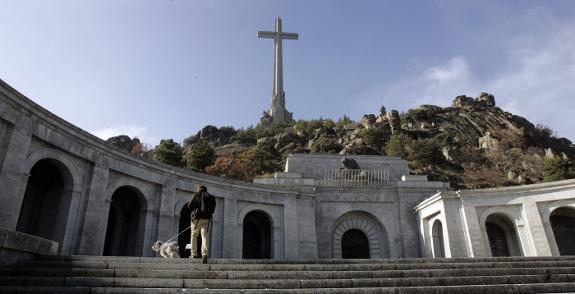The valley in which Franco didn't want to be buried
The imminent transfer of the dictator's remains has started a debate about the future use of the monument in the Madrid hills
A. AZPIROZ
Viernes, 6 de julio 2018, 13:35
"As a democracy, Spain cannot permit symbols which separate Spanish people. Something which would be unimaginable in Germany or Italy cannot be allowed in this country either. It is a question of closing wounds."
In his first interview as prime minister, Pedro Sánchez made it clear that he would change the present status of the Valley of the Fallen, and that includes removing the remains of dictator Francisco Franco from the mausoleum and burying them elsewhere, something which his socialist predecessors Felipe González and José Luis Rodríguez Zapatero either didn't want or didn't dare to do. The decision has now been taken. The move will be made before August.
What is strange in these 43 years of debate about the Valley of the Fallen is that Franco didn't ask to be buried in this monument, which he ordered to be built in an idyllic setting in the Madrid hills. His intention was to be buried in a chapel at the Mingorrubio cemetery, near El Pardo palace, which is where the remains of his wife, Carmen Polo, lie.
"There was no way that Franco wanted to go to the Valley of the Fallen," insists Juan de Ávalos, architect, painter and son of the sculptor of the same name who was commissioned to create the statues which adorn the monument.
De Ávalos has the same close relationship with the site as his father, whose appointment upset some elements of the Franco regime because he was a republican. "At that time, you could be republican but not left-wing," says Juan junior.
He says that when the dictator suffered his first haemorrhage, Carmen Polo went to look at the chapel at Mingorrubio. "When Franco asked what it was like, she told him it was too luxurious. If she thought that about the chapel, I imagine the Valley of the Fallen would have been considered very grand indeed, to say the least" he says.
Wishes set aside
With Franco dying, Arias Navarro's government decided to leave aside the dictator's wishes and prepare a place for him inside the Valley of the Fallen. According to De Ávalos, just a few days before the burial the managing director of a construction firm was commissioned to prepare the tomb. When Franco died, King Juan Carlos signed an order which declared that he was to be buried in the Valley of the Fallen.
The decision to bury Franco at the Valley of the Fallen has linked the monument with the dictatorship ever since, something which Pedro Sánchez's government considers can be corrected by moving his remains.
The socialists want to reform the Law of Historic Memory and transform the monument into a National Memorial Centre so it is no longer a place of memory for Francoism and Catholic nationalism. Instead, they want it to become a place "for the culture of reconciliation, democratic collective memory, and dignity and recognition for the victims of the Civil War and the dictatorship".
Albert Rivera of the Ciudadanos party would rather it became a national cemetery, similar to that of Arlington in the USA, where American soldiers who died in combat are buried. For Izquierda Unida it should be desacralized and just renamed 'Cuelgamuros Valley'. Compromís senator Carles Mulet goes further still: he wants the monument to be demolished, as the only way of not leaving "reminiscences".
De Ávalos has a proposal of his own, nothing to do with politics and based on reconciliation and his passion for art. "I think what they should do is promote it as the result of the work of artists, engineers, stonemasons, builders and painters. A lot of culture lies within that," he says. He is in favour of a museum to hold the vast amount of documentation written about the Valley of the Fallen and its construction. With regard to the burials, he says if the relatives of any the more than 33,000 people buried there don't want their loved one to lie beneath the cross, they should be offered another position within the complex, and finally he proposes that the black marble which decorates each side of the entrance to the basilica be inscribed with the names of all those buried there, no matter which side they fought for. "And in strict alphabetical order," he says.
